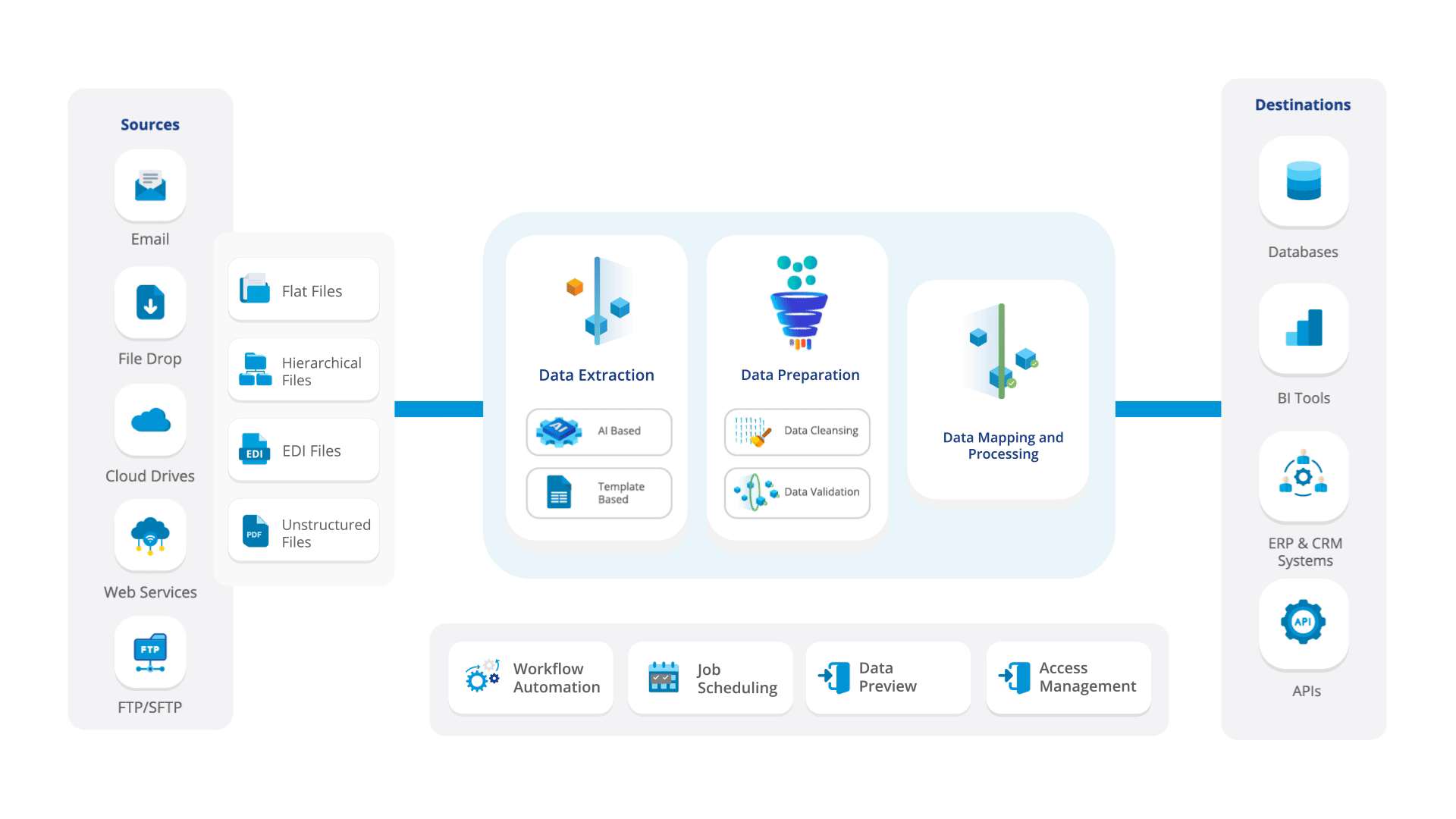
A Complete Guide to Data Enrichment
Businesses rely heavily on data to make informed decisions, understand customers and facilitate growth. However, the quality and depth of data can vary significantly, often leaving raw data insufficient to yield effective outcomes. Data enrichment can help you meet these expectations, enrich customer experiences, optimize cost-efficiency, and eliminate redundant data.
What is Data Enrichment?
Data enrichment is a process that enhances raw data with additional context, making it more useful for business insights and decisions. It allows you to add new data or add supplementary information such as demographic details, and behavioral insights to provide a more accurate, actionable, and complete dataset.
Data enrichment further offers the ability to cross-reference, refine, and weave together data from multiple sources to make a unified whole. The result is a unified, all-encompassing dataset that reveals previously concealed insights and opportunities so you can make educated and strategic decisions.
Elevate Your Data Quality, Zero-Coding Required
High quality data is the backbone of data-driven companies. Clean and validate your unstructured data in a code-free interface with Astera. Automate your data prep now!
View DemoExamples of Data Enrichment
Data enrichment can take various forms. For example, customer data enrichment focuses on upgrading customer-related data with additional information to reach a wider audience and provide a more personalized experience. For example:
- Customer Insight Amplification: By appending social media profiles to existing customer contact information, businesses can gain a more comprehensive view of customer preferences and behaviors.
- Market Trend Integration: Incorporating current market trends into sales data can help companies anticipate shifts in consumer demand and adjust their strategies accordingly.
- Transaction History Enrichment: Enriching customer records with recent transaction history can provide valuable context for personalized marketing and improved customer service.
Importance of Data Enrichment
Trusted data is key for businesses to make informed decisions. Raw data often comes with inconsistencies and lacks depth because of data silos. Cleaning, standardizing, enriching, and verifying this raw data offer multiple benefits for organizations and their customers.
-
Breaking Down Data Silos
Data integration from multiple sources provides a unified data view, enabling the identification of hidden trends or patterns. These trends can be further used to predict customer behavior and optimize marketing campaigns.
-
Giving Context to the Raw Data
Giving a proper context to a raw data set is essential to extract meaningful insights. Customer data enrichment provides missing context by linking the data with relevant information and for instance, linking demographics and purchasing habits to social media activity or location-based behavior patterns. By adding context, organizations can gain a richer understanding of the data.
-
Improved Customer Understanding
Data enrichment provides context to the raw data and combines the existing customer data with external sources or third-party data. Enriching customer data helps organizations better understand their customer base, like their brand affinities and preferences.
-
Improved Response Time
Businesses that rely on immediate and emergency responses understand the importance of accurate and readily available data. Data enrichment gives response teams more information to plan and execute the response.
Data Cleansing vs. Data Enrichment
Data cleansing and data enrichment serve distinct but complementary roles in data management. Both concepts are indispensable to the data preparation process. Data cleansing is primarily concerned with the accuracy and consistency of data within a dataset. It consists of processes that help you correct errors, remove duplicates, and ensure that your data is updated. This is akin to tidying up a room to be clean and orderly.
On the other hand, data enrichment is about adding value to the existing dataset by appending new, relevant information from external sources. If data cleansing is about cleaning the room, data enrichment is about furnishing it with new, valuable items that enhance its functionality and appeal.
Data Enhancement vs. Data Enrichment
While data enhancement and enrichment are often used interchangeably, they have subtle differences.
Data enrichment typically refers to the process of improving, refining, or enhancing existing data by adding additional information or attributes to it. This can involve appending data from external sources to enrich the original dataset. For example, if you have a customer database with names and email addresses, data enrichment might involve adding demographic information such as age, gender, or location to provide a more comprehensive profile of each customer.
On the other hand, data enhancement is a broader term encompassing various methods and techniques to improve the quality, usability, or value of data. While data enrichment is one way to enhance data, other methods exist. These may include data cleaning to remove errors or inconsistencies, data normalization to ensure consistency across different datasets, or data integration to combine multiple datasets into a single, unified view. Both processes aim to increase the value of your data but approach it from different angles.
| Data Enrichment |
Data Enhancement |
|
| Purpose | Enhancing existing data by adding additional information to make it more comprehensive and valuable. | Improving overall data quality, usability, and value through various methods and techniques. |
| Process | – Identifying relevant external data sources.
– Acquiring additional data from external sources. – Integrating new data with existing dataset. – Matching and merging new data with existing data. – Updating and validating enriched data. |
– Data cleaning: Removing errors, duplicates, etc.
– Data normalization: Ensuring consistency across different datasets. – Data integration: Combining multiple datasets into a unified view. – Data enrichment: Adding additional information to existing data. |
| Results | – Comprehensive and enriched dataset.
– More detailed insights and analysis. – Better understanding of customers or entities. |
– Improved data quality and accuracy.
– Enhanced usability and accessibility of data. – Increased value and utility of data for decision-making and analysis. |
Benefits of Data Enrichment
The data enrichment solution market will touch $3.5 billion by 2030, which is huge. The popularity of these solutions can be attributed to the many benefits that come with data enrichment. Here are some of the most prominent benefits of data enrichment:

- Informed Decision Making: Enriched data gives decision-makers a complete picture so they can make informed decisions, whether it is regarding new product creation or market expansion.
- Improved Customer Profiling: This is the age of hyper-personalization. Data enrichment can add demographic details like age, gender, income, and marital status to customer profiles so you can subsequently tailor your marketing efforts. For instance, a clothing retailer can use age and gender data to recommend relevant clothing styles to their customers.
- Competitive Advantage: Enriched data enables organizations to stay ahead of the competition by identifying market trends, understanding customer preferences, and adapting to changing market conditions.
- Cost Reduction: The best part about data enrichment is that it saves you tons of costs because then you can avoid costly errors. For example, if you have a database of customers, you can enrich the data with the right information and ensure that your marketing materials reach the right addresses.
Data Enrichment Techniques
So, how can you enhance the quality of your data and ensure it provides value? Techniques include:
- Data Consolidation: This technique can add new data fields or attributes to existing records. For instance, you can enrich a customer database with demographic information such as age, gender, and income.
- Data Validation and Correction: One of the most critical factors in data enrichment is ensuring the accuracy and integrity of data by validating and correcting inconsistencies, errors, or missing values, for example, validating email addresses, fixing formatting issues in addresses, or standardizing date formats.
- Geospatial Enrichment: You can add geographic data to records, such as latitude and longitude coordinates, city, state, or ZIP code. So, if you must do a location-based analysis, this can be useful in that scenario.
- Social Media Profiling: To gain a deeper understanding of your customers, you can enrich customer data with information from social media platforms, such as Twitter, LinkedIn, or Facebook profiles.
- Data Standardization: Standardizing data involves converting data into a consistent format. This can include standardizing units of measurement, date formats, or address formatting (e.g., converting “St.” to “Street”).
- Data Matching and Deduplication: Duplicate records are a common issue with raw data. Data matching identifies and merges duplicate records within a dataset to ensure data consistency and eliminate redundancy.
9 Steps for Data Enrichment
Let’s walk through an example of data enrichment in the financial industry. If you are a bank manager who wants to enrich customer data to improve service personalization, you should follow these steps.

Step 1: Data Collection and Preparation
First, determine the dataset and data elements you want to enrich. Collect and compile them and make sure they are clean and free of obvious errors. You can leverage data integration tools to access and consolidate customer databases and transaction logs. Doing so will help you gain access to data connectors while supporting data type conversions and error logging to identify and rectify discrepancies.
Step 2: Define Data Enrichment Goals
Clearly define the objectives of your data enrichment project. What specific enhancements are you looking to achieve? Are you interested in demographic data, geospatial information, or other attributes?
In the example, you aim to enrich customer financial behavior data with additional attributes such as investment patterns, risk tolerance, and preferred transaction channels to offer more personalized services.
Step 3: Clean Data
Once you have laid the groundwork, initiate your data enrichment journey by meticulously tending to data cleanliness and consistency. Data cleansing allows you to eliminate any duplicates, rectify inaccuracies, and standardize data formats. For instance, aligning customer phone numbers to a uniform format makes it usable across systems.
Step 4: Segment and Profile Data
Utilize the power of data segmentation and profiling to divide your dataset into meaningful segments guided by specific criteria. Data profiling will give you a complete picture of your data. It will assess the quality of your data by looking for inconsistencies, errors, and outliers and identify the data that doesn’t conform to expected patterns or business rules. For example, data profiling tools will help you detect inconsistencies in the customer data stored by your bank. It will also allow you to segment customers based on transactional behavior, product usage, and interaction channels. For instance, you might create segments such as ‘High-Value Customers,’ ‘Frequent Online Users,’ ‘Loan Seekers,’ or ‘Young Professionals.’
Step 5: Match and Integrate Data
Data integration involves matching and merging records based on shared identifiers, reconciling data from multiple sources, and creating a cohesive dataset as a single source of truth. The integrated dataset will set the foundation for advanced analytics, reporting, and strategic planning.
Data matching tools will help you merge related records across different systems using unique identifiers like customer IDs. This helps create a unified view of each customer’s interactions with the bank.
Step 6: Data Consolidation
Data consolidation enriches your dataset by adding external context. It’s a pivotal step because it deepens the dataset’s dimensions. You may append external data, such as credit scores from credit bureaus and geospatial data for regional analysis, to its customer profiles. This provides a more comprehensive view of the customer’s financial standing and geographical distribution.
Step 7: Data Aggregation
Aggregation summarizes data, vital for spotting trends that inform strategic decisions. You can summarize the data by region using aggregation tools, which will help you spot trends in customer behavior. This will inform your decisions on where to focus marketing efforts and where to expand services.
Step 8: Data Transformation
Transformation prepares data for analysis. It’s a critical step in the ETL process because it converts data into actionable intelligence.
In this example, you can leverage data transformation tools to calculate new metrics, such as average transaction value, frequency of branch visits, and digital engagement scores. These metrics help classify customers into categories like ‘digital natives’ or ‘branch loyalists,’ aiding in targeted marketing and service design.
Step 9: Validate Data and Implement Quality Control
Safeguard data accuracy and reliability through regular validation and verification procedures. Implement stringent quality control checks to detect errors early, fortifying data integrity and trustworthiness. A proactive approach will ensure that your enriched dataset remains dependable for driving strategic actions and decisions.
You can leverage automated data quality tools to monitor data integrity continuously. They will help you perform regular checks against transaction logs and external data sources to ensure the accuracy and reliability of the enriched data.
Types of Datasets
Enriching suitable datasets can become a valuable tool in the decision-making process. Different types of data sets contribute to a company’s goals.
-
Customer Data
Customer data enrichment goes beyond just updating names and emails. It includes demographics, purchase history, and website behavior data, which can create a much richer customer base. Enriched customer data also empowers you to predict customer behavior, enabling proactive service and targeted product recommendations that ultimately drive customer satisfaction and loyalty.
-
Sales Data
Sales data is valuable but enriching it with market trend data and customer demographics can transform it into a strategic tool. You can identify upselling and cross-selling opportunities by understanding market shifts and customer preferences alongside sales figures. It also helps you accurately forecast future sales trends and optimize your pricing strategies to maximize profitability.
-
Marketing Campaign Data
Campaign data tells you how many emails were opened, or links clicked. Enriching it with customer demographics and website behavior data allows you to evaluate the effectiveness of your campaigns across different audience segments and channels. This empowers you to identify high-performing channels and tailor future campaigns for maximum impact through audience segmentation.
-
Financial Data
Enriching financial data with market data and economic indicators adds valuable context. By understanding how interest rates, currency exchange rates, and broader economic factors influence your financial performance, you can improve the accuracy of your budgeting and forecasting. Enriched financial data also helps identify cost-saving opportunities and empowers you to make informed risk assessments.
-
Operational Data
Enriching operational data with weather, traffic, and supplier performance information allows you to optimize delivery routes, schedule preventive maintenance for equipment, and identify operational bottlenecks that hinder efficiency. This information translates to smoother operations, reduced downtime, and, ultimately, a more cost-effective business model.
Data Enrichment Tools and Technologies
Now that you are aware of how data enrichment works what its benefits are, let’s explore some of the tools and technologies through which you can implement data enrichment:
Data Enrichment Software
These solutions are often used for specific, niche enrichment tasks. They provide targeted improvements to your data and allow for fine-tuning enrichment processes.
Key Features
- Specialized Functions: These software packages may focus on tasks like email validation, geocoding, or social media data extraction.
- Customization: They offer customizable options to tailor the enrichment process to your unique requirements.
APIs for Data Enrichment
Application Programming Interfaces (APIs) allow you to integrate data enhancement directly into your applications and workflows by providing real-time or batch data enrichment.
Key Features
- Real-time Enrichment: APIs can enrich data in real-time as it’s collected or utilized in your applications.
- Customization: You can tailor APIs to your specific needs and leverage flexibility in accessing and using enrichment services.
- Scalability: APIs can handle large volumes of data, making them suitable for high-demand applications.
Data Integration Tools
Another option is data integration software. These tools have advanced data cleansing, quality, and profiling features that clean and standardize your data. They also have data integration capabilities, so you can easily combine data from multiple sources to get a complete view.
Key Features
- Advanced data quality management, profiling, and cleansing features
- Built-in connectors to extract data from multiple sources and integrate it to form a unified view
- Advanced built-in transformations and functions so you can easily manipulate data however you want.
Automated Data Enrichment
Automated data enrichment streamlines data enrichment by automatically updating and consolidating existing datasets with additional, relevant information. This process is typically powered by predefined rules and algorithms that work to identify, verify, and incorporate new data points into an existing database without manual input.

New data is validated for accuracy and relevance before merging with existing records. This process adds depth to the data and helps maintain a clean and organized database primed for analysis.
Key Features
- Real-Time Processing: Automatically updates and enriches data as it is collected.
- Scalability: Handles increasing volumes of data without compromising performance.
- Customization: Offers the ability to configure rules and parameters to meet specific data enrichment needs.
- Data Transformation: Converts data into the required format or structure for analysis or reporting purposes.
- Automated Workflows: Sets up triggers and actions to automate the entire data enrichment process.
Best Practices for Data Enrichment
Optimizing data enrichment processes requires a strategic approach. To harness the full potential of your data, consider these best practices that emphasize precision, consistency, and adaptability:

Start with High-Quality Data
- Ensure the foundation of data enrichment is clean and accurate.
- Use data munging to enhance dataset quality.
- Deduplicate entries, rectify inaccuracies, and standardize data formats.
Use Multiple Sources of Data
- Expand data collection by tapping into diverse sources.
- Integrate information from customer databases, web analytics, IoT sensors, and ERP solutions.
- Construct a multidimensional view for deeper insights and understanding.
Keep Your Data Up to Date
- Regularly update your dataset to maintain relevance and accuracy.
- Stay current with market trends and customer preferences.
Automate Your Data Enrichment Processes
- Leverage data automation to reduce manual workload and human error.
- Ensure uniform data processing to maintain data integrity.
- Implement efficient workflows with purpose-built tools for data enrichment.
Monitor Your Data Enrichment Results
- Keep track of the impact of data enrichment on operations.
- Monitor KPIs to gauge effectiveness.
- Regularly evaluate and adapt your data enrichment strategies for continuous improvement.
Data Enrichment Use Cases
B2C and B2B Data Enrichment
B2C (Business-to-Consumer) and B2B (Business-to-Business) data enrichment is pivotal in deepening relationships and driving sales. For B2C companies, enriching customer data with personal preferences, purchase history, and social media activity can tailor experiences to individual needs. B2B firms benefit similarly by enriching prospect data with industry trends, company size, and decision-maker information to personalize outreach and proposals.
Example: A B2C fashion retailer uses data enrichment to recommend clothing items based on a customer’s past purchases and browsing behavior, while a B2B software provider leverages enriched data to customize software solutions for potential clients based on their business requirements.
Customer Data Enrichment
Customer data enrichment is about creating a comprehensive profile of your customers. Businesses can gain insights into customer behavior, preferences, and needs by integrating data from various touchpoints. This enriched view enables companies to deliver more personalized services and anticipate customer needs.
Example: A telecom operator enriches customer profiles with usage patterns and service preferences to offer tailored data plans and value-added services, increasing customer satisfaction and loyalty.
Financial Data Enrichment
Financial data enrichment is crucial for accuracy in reporting and compliance with regulatory standards. Financial institutions can improve fraud detection, risk assessment, and customer service by enriching transaction data with contextual information.
Example: A bank enriches transaction data with merchant information and location data to detect unusual activity and prevent fraud, ensuring secure customer accounts.
Marketing Data Enrichment
Marketing data enrichment allows businesses to refine their targeting strategies. Marketers can create more effective campaigns that resonate with their audience by adding demographic, psychographic, and behavioral data to customer profiles.
Example: A marketing agency enriches its database with social media interests and engagement data to create targeted ad campaigns with higher conversion rates.
E-commerce Data Enrichment
E-commerce data enrichment enhances the online shopping experience by personalizing product recommendations, optimizing search functionality, and improving customer service. By understanding customers’ shopping habits and preferences, e-commerce platforms can increase sales and customer retention.
Example: An e-commerce platform enriches user profiles with browsing history and purchase data to provide personalized product recommendations, increasing sales and customer engagement.
A Guide to Data Quality Management
Data Quality Management helps organizations use their data to the fullest. Download our free guide and learn how you maximize the potential of your organizational data.
Download Your Free GuideStreamline Data Enrichment with Astera
Realizing the full potential of data enrichment requires understanding its principles, implementing efficient processes, and leveraging advanced technologies. This is where solutions like Astera come into play.

Astera is an end-to-end data management platform with advanced data extraction, integration, preparation, and automation capabilities, empowering businesses to streamline their data enrichment workflows.
It’s a code-free solution with an intuitive, drag-and-drop user interface designed with accessibility and usability in mind. Some essential features of Astera include:
- AI-powered data extraction to ingest data from unstructured sources.
- Streamline the entire data preparation process, from integration to transformation, saving valuable time and resources.
- A wide array of transformations to shape and refine your data to meet analysis requirements.
- Built-in data quality and cleansing features with customizable checks and rules to maintain data accuracy and consistency.
- A visual, interactive grid that allows you to explore data visually and enables hands-on, immediate data cleansing and adjustments.
- to explore and interact with data in an intuitive and user-friendly manner.
- Built-in job scheduler and automation capabilities to eliminate manual work.
Want to get the best out of your data? Try Astera DataPrep. Start your journey with a 14-day free trial and see how the code-free tool can help you get insights from your data.
 Astera AI Agent Builder - First Look Coming Soon!
Astera AI Agent Builder - First Look Coming Soon!


